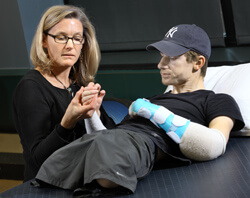

How a Johns Hopkins hand therapist keeps transplanted hands in shape until they can be used.
The occupational therapist gently unwraps the splint and bandage on her patient’s left arm, then carefully massages his hand, one finger at a time, with her strong, knowledgeable fingers. Settling back on his pillow, the young man closes his eyes while she turns her attention to his right arm. For four hours a day, six days a week, these two engage in the slow work of healing. Their mission: bringing two hands and 10 fingers to renewed strength and purpose.
It’s a sacred moment, one of many occurring in the hospital at intersections of hope, determination and expertise. Yet no recent case better captures such spirit than that of Brendan Marrocco, the 26-year-old Iraq War veteran from Staten Island who lost both of his arms and legs to a roadside bomb.
In December 2012, W.P. Andrew Lee, Johns Hopkins Hospital’s director of the Department of Plastic and Reconstructive Surgery, led a 16-member team of surgeons in a meticulously planned transplant operation that brought Brendan two new arms, courtesy of a deceased donor. Now the former Army sergeant is on the long journey toward recovery. Gaining sensation in his new limbs will require extraordinary doses of patience as well as perseverance.
Since the 2009 attack, Marrocco has relied on his shoulders and left elbow to propel his wheelchair, and still does. These muscles also enable him to move the new arms he cannot yet feel. Because nerves can only grow an inch a month at most, it may take several years before those in the remainder of his original arms regenerate into his transplanted limbs and reinnervate the new muscles to function as they should.
For now, Molly Ferris, a certified hand therapist in the Department of Physical and Rehabilitation Medicine, performs his exercises. “I do all the motion for him to keep the joints supple and the tissue its proper length,” she explains. “I move his arms up and down and side to side to maintain the passive range of motion. As the nerves regenerate, we try to work more into the active range of motion for those muscles.”
Ferris began working with Marrocco three days after his transplant on Dec. 18. Now, at a therapy session at the Johns Hopkins Outpatient Center, she first checks Marrocco’s skin to make sure that his protective splint is not chafing and looks for telltale red dots that might indicate that his body is rejecting his arms. She also examines his surgical scars for adhesions.
In silent concentration, his expression shaded by a New York Yankees cap, Marrocco watches Ferris guide his fingers through their familiar routine, joint by joint. She bends his wrists and turns each arm back and forth as if she were rousing it from a deep sleep. This graceful, therapeutic choreography of curling and uncurling, tilting and twisting, extending and flexing underscores the potential of his arm—and the importance of her work.
Later, Marrocco uses the active muscles of his shoulders and upper arms to move his lower arms across his chest and behind his head. He squeezes a ball between his elbows to strengthen his triceps and chest. At one point, he tosses the ball back and forth with Ferris to improve his eye-hand coordination as well as his body’s spatial awareness.
The hand therapist usually works with people who have tendinitis, finger fractures or wrist fractures. Never before has she worked for so long with someone in such an intensive way. She will continue to meet with Marrocco, she says, until he begins the next stage of recovery at Walter Reed National Military Medical Center, sometime this spring.
Along the way, there have been flutters of encouragement.
Like some expectant mothers, Marrocco will see evidence of new life before he feels it. Although he and Ferris weren’t sure at first, both have seen twitches near his left elbow that signal nerves on the move.
“I was afraid that it was one of those things that you want to see so badly that you think you see it when you don’t,” Ferris says. “But then we got others to confirm it.”
Although the contraction near his left elbow occurs involuntarily, she believes that Marrocco may have managed to cause it himself on at least one occasion. And just the other day, she says, it happened again.
—Linell Smith

